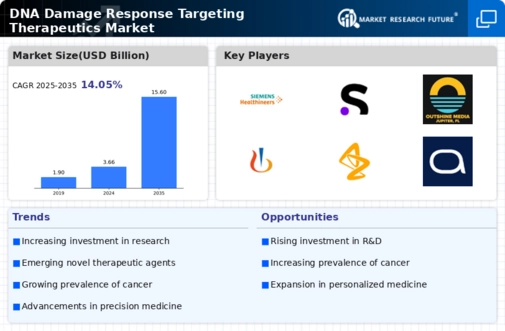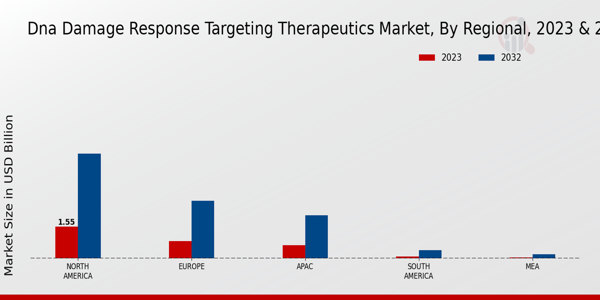Increasing Cancer Incidence
The rising global incidence of cancer is a primary driver for the Global DNA Damage Response Targeting Therapeutics Market Industry. As cancer remains a leading cause of mortality worldwide, the demand for innovative therapies that target DNA damage response mechanisms is escalating. In 2024, the market is projected to reach 3.66 USD Billion, reflecting the urgent need for effective treatments. The increasing understanding of the molecular underpinnings of cancer has led to the development of targeted therapies that exploit DNA damage response pathways, potentially improving patient outcomes. This trend is expected to continue, with the market anticipated to grow significantly in the coming years.
Advancements in Precision Medicine
Advancements in precision medicine are reshaping the landscape of the Global DNA Damage Response Targeting Therapeutics Market Industry. Tailored therapies that consider individual genetic profiles are becoming increasingly prevalent, allowing for more effective treatment strategies. This shift towards personalized medicine is driven by the integration of genomic data into clinical practice, enabling healthcare providers to select therapies that specifically target DNA repair mechanisms. As a result, the market is expected to experience robust growth, with projections indicating a rise to 15.6 USD Billion by 2035. The focus on precision medicine not only enhances treatment efficacy but also minimizes adverse effects, thereby improving patient quality of life.
Growing Investment in Oncology Research
The surge in investment in oncology research is a significant catalyst for the Global DNA Damage Response Targeting Therapeutics Market Industry. Governments and private entities are increasingly allocating funds to explore novel therapeutic approaches that target DNA damage response pathways. This influx of capital is facilitating the development of innovative therapies and clinical trials aimed at understanding the complexities of DNA repair mechanisms. As a result, the market is poised for substantial growth, with a projected compound annual growth rate (CAGR) of 14.07% from 2025 to 2035. This investment trend underscores the commitment to advancing cancer treatment options and improving patient outcomes.
Emerging Biomarkers for Treatment Selection
The identification of emerging biomarkers for treatment selection is transforming the Global DNA Damage Response Targeting Therapeutics Market Industry. Biomarkers play a crucial role in determining patient eligibility for specific therapies that target DNA damage response pathways. The integration of biomarker testing into clinical practice enhances the precision of treatment decisions, leading to improved patient outcomes. As research continues to uncover novel biomarkers associated with DNA repair mechanisms, the market is expected to expand significantly. This trend aligns with the broader movement towards personalized medicine, where treatment strategies are tailored to individual patient profiles, thereby optimizing therapeutic efficacy.
Regulatory Support for Innovative Therapies
Regulatory support for innovative therapies is enhancing the Global DNA Damage Response Targeting Therapeutics Market Industry. Regulatory agencies are increasingly recognizing the importance of expedited approval processes for breakthrough therapies that target DNA damage response mechanisms. This supportive environment encourages pharmaceutical companies to invest in research and development, leading to a more robust pipeline of potential treatments. The favorable regulatory landscape not only accelerates the availability of new therapies but also fosters competition among manufacturers, ultimately benefiting patients. As the market evolves, this regulatory momentum is likely to contribute to sustained growth and innovation in the field.

























Leave a Comment